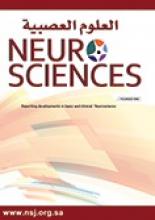Research ArticleOriginal Article
Open Access
Dissociative features of fibromyalgia syndrome
Tonguc D. Berkol, Yasin H. Balcioglu, Simge S. Kirlioglu, Habib Erensoy and Meltem Vural
Neurosciences Journal July 2017, 22 (3) 198-204; DOI: https://doi.org/10.17712/nsj.2017.3.20160538
Tonguc D. Berkol
From the Department of Psychiatry, Bakırkoy Research and Training Hospital for Psychiatry, Neurology and Neurosurgery (Berkol, Balcioglu, Kirlioglu), from the Department of Psychiatry (Erensoy), Neuropsychiatry Hospital, Uskudar University, and from the Department of Physical Medicine and Rehabilitation (Vural), Physical Medicine and Rehabilitation Hospital, Istanbul, Turkey
MDYasin H. Balcioglu
From the Department of Psychiatry, Bakırkoy Research and Training Hospital for Psychiatry, Neurology and Neurosurgery (Berkol, Balcioglu, Kirlioglu), from the Department of Psychiatry (Erensoy), Neuropsychiatry Hospital, Uskudar University, and from the Department of Physical Medicine and Rehabilitation (Vural), Physical Medicine and Rehabilitation Hospital, Istanbul, Turkey
MDSimge S. Kirlioglu
From the Department of Psychiatry, Bakırkoy Research and Training Hospital for Psychiatry, Neurology and Neurosurgery (Berkol, Balcioglu, Kirlioglu), from the Department of Psychiatry (Erensoy), Neuropsychiatry Hospital, Uskudar University, and from the Department of Physical Medicine and Rehabilitation (Vural), Physical Medicine and Rehabilitation Hospital, Istanbul, Turkey
MDHabib Erensoy
From the Department of Psychiatry, Bakırkoy Research and Training Hospital for Psychiatry, Neurology and Neurosurgery (Berkol, Balcioglu, Kirlioglu), from the Department of Psychiatry (Erensoy), Neuropsychiatry Hospital, Uskudar University, and from the Department of Physical Medicine and Rehabilitation (Vural), Physical Medicine and Rehabilitation Hospital, Istanbul, Turkey
MDMeltem Vural
From the Department of Psychiatry, Bakırkoy Research and Training Hospital for Psychiatry, Neurology and Neurosurgery (Berkol, Balcioglu, Kirlioglu), from the Department of Psychiatry (Erensoy), Neuropsychiatry Hospital, Uskudar University, and from the Department of Physical Medicine and Rehabilitation (Vural), Physical Medicine and Rehabilitation Hospital, Istanbul, Turkey
MD
References
- ↵
- Spaeth M,
- Bennett RM,
- Benson BA,
- Wang YG,
- Lai C,
- Choy EH
- ↵
- López-Roig S,
- Pastor MÁ,
- Peñacoba C,
- Lledó A,
- Sanz Y,
- Velasco L
- ↵
- Ting TV,
- Barnett K,
- Lynch-Jordan A,
- Whitacre C,
- Henrickson M,
- Kashikar-Zuck S
- ↵
- Choy E,
- Perrot S,
- Leon T,
- Kaplan J,
- Petersel D,
- Ginovker A,
- et al.
- ↵
- Carbonell-Baeza A,
- Ruiz JR,
- Aparicio VA,
- Ortega FB,
- Munguía-Izquierdo D,
- Alvarez-Gallardo IC,
- et al.
- ↵
- Perrot S,
- Choy E,
- Petersel D,
- Ginovker A,
- Kramer E
- ↵
- Bellato E,
- Marini E,
- Castoldi F,
- Barbasetti N,
- Mattei L,
- Bonasia DE,
- et al.
- ↵
- Williams DA,
- Kratz AL
- ↵
- Arnold LM,
- Clauw DJ,
- McCarberg BH;FibroCollaborative
- van Middendorp H,
- Kool MB,
- van Beugen S,
- Denollet J,
- Lumley MA,
- Geenen R
- ↵
- Chang MH,
- Hsu JW,
- Huang KL,
- Su TP,
- Bai YM,
- Li CT,
- et al.
- ↵
- Bohn D,
- Bernardy K,
- Wolfe F,
- Häuser W
- Evren C,
- Cinar O,
- Evren B,
- Ulku M,
- Karabulut V,
- Umut G
- Haviland M,
- Morton KR,
- Oda K,
- Fraser GE
- ↵
- Neigh GN,
- Ali FF
- ↵
- Danis R,
- Llacer JB,
- Bouza RG
- ↵
- Häuser W,
- Henningsen P
- Fayed N,
- Andres E,
- Rojas G,
- Moreno S,
- Serrano-Blanco A,
- Roca M,
- et al.
- ↵
- Kollmann J,
- Gollwitzer M,
- Spada MM,
- Fernie BA
- ↵
- Kilic O,
- Sar V,
- Taycan O,
- Aksoy-Poyraz C,
- Erol TC,
- Tecer O,
- et al.
- ↵
- Haviland MG,
- Morton KR,
- Oda K,
- Fraser GE
- ↵
- Farina B,
- Mazzotti E,
- Pasquini P,
- Giuseppina Mantione M
- ↵
- Schäfer I,
- Fisher HL,
- Aderhold V,
- Huber B,
- Hoffmann-Langer L,
- Golks D,
- et al.
- ↵
- Van der Kruijs SJ,
- Bodde NM,
- Vaessen MJ,
- Lazeron RH,
- Vonck K,
- Boon P,
- et al.
- ↵
- Van der Boom KJ,
- van den Hout MA,
- Huntjens RJ
- ↵
- Sluka KA,
- Clauw DJ
- ↵
- Johnson AL,
- Storzbach D,
- Binder LM,
- Barkhuizen A,
- Anger WK,
- Salinsky MC,
- et al.
- ↵
- Santos Dde M,
- Lage LV,
- Jabur EK,
- Kaziyama HHS,
- Iosifescu DV,
- de Lucia MCS,
- et al.
- Salazar A,
- Dueñas M,
- Mico JA,
- Ojeda B,
- Agüera-Ortiz L,
- Cervilla JA,
- et al.
- ↵
- Fiest KM,
- Currie SR,
- Williams JV,
- Wang J
- ↵
- Aguglia A,
- Salvi V,
- Maina G,
- Rossetto I,
- Aguglia E
- ↵
- Busch AJ,
- Webber SC,
- Brachaniec M,
- Bidonde J,
- Dal Bello-Haas V,
- Danyliw A,
- et al.
- ↵
- Rodewald F,
- Wilhelm-Göling C,
- Emrich HM,
- Reddemann L,
- Gast U
- Moscariello MM,
- Ratti F,
- Quartini A,
- Forcén FE,
- Munuera JN,
- Bersani G
- ↵
- Selvi Y,
- Besiroglu L,
- Aydin A,
- Gulec M,
- Atli A,
- Boysan M,
- et al.
- ↵
- Vural M,
- Berkol TD,
- Erdogdu Z,
- Kucukserat B,
- Aksoy C
In this issue
Dissociative features of fibromyalgia syndrome
Tonguc D. Berkol, Yasin H. Balcioglu, Simge S. Kirlioglu, Habib Erensoy, Meltem Vural
Neurosciences Journal Jul 2017, 22 (3) 198-204; DOI: 10.17712/nsj.2017.3.20160538
Jump to section
Related Articles
- No related articles found.
Cited By...
- No citing articles found.





